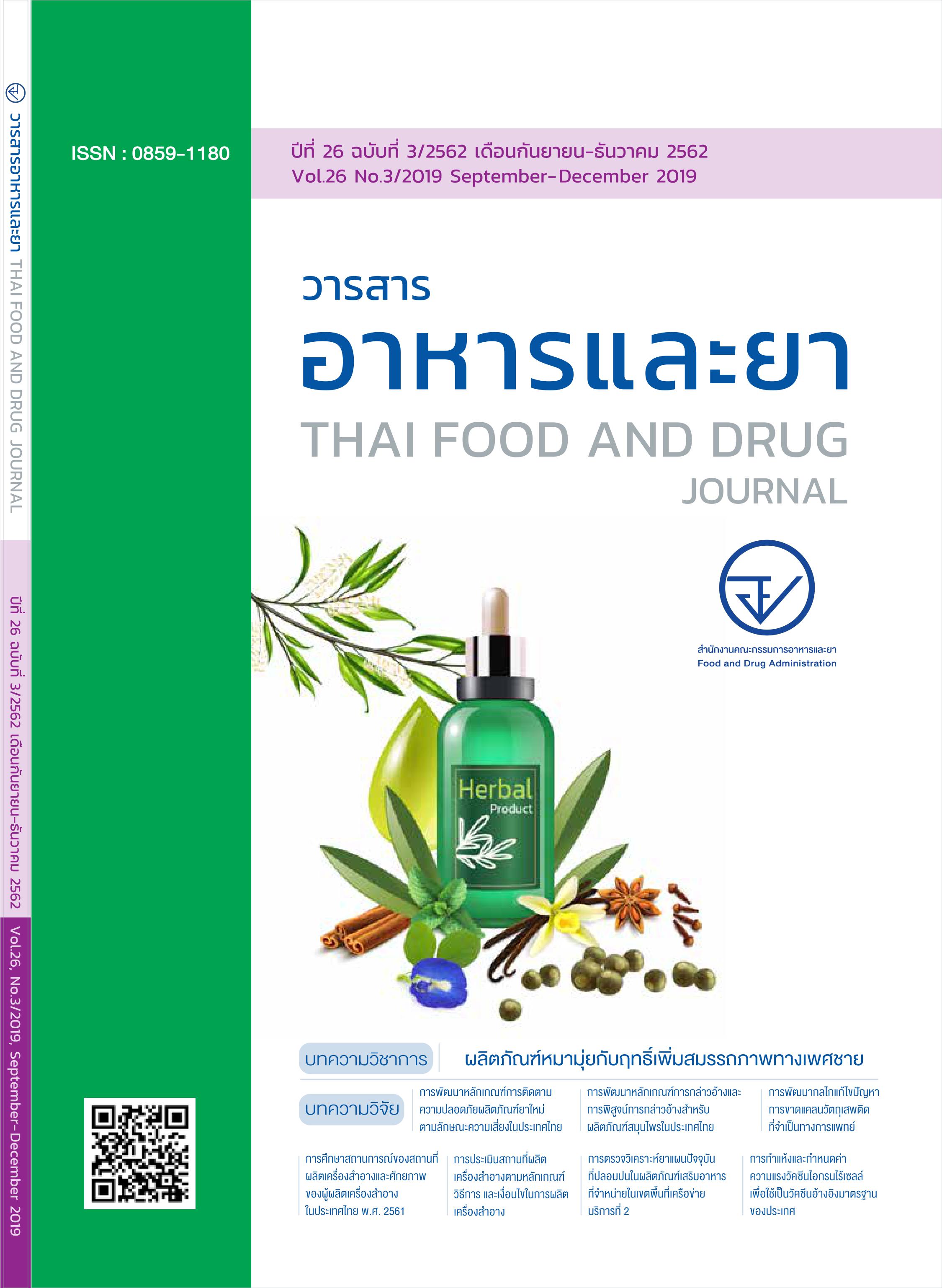การตรวจวิเคราะห์ยาแผนปัจจุบันที่ปลอมปนในผลิตภัณฑ์เสริมอาหารอาหาร ที่จำหน่ายในเขตพื้นที่เครือข่ายบริการที่ 2
Main Article Content
บทคัดย่อ
ยาลดความอ้วน เป็นยาที่ทำให้น้ำหนักลดลง และต้องอยู่ภายใต้ความดูแลของแพทย์ การใช้ยา
ลดน้ำหนักทุกชนิดจะทำให้น้ำหนักลดลงได้ในช่วงที่กินยา แต่น้ำหนักจะกลับขึ้นเท่าเดิมหรือมากกว่าเดิม
เมื่อหยุดยาด้วยอาการที่เรียกว่า yo-yo-effect คือผู้ใช้ยาจะมีน้ำหนักเพิ่มขึ้นกว่าเดิมมาก ในปีงบประมาณ
2557 ผู้วิจัยได้จัดทำโครงการตรวจเอกลักษณ์หายาลดความอ้วนในผลิตภัณฑ์เสริมอาหารลดน้ำหนักที่ซื้อจากร้านจำหน่ายในเขตพื้นที่เครือข่ายบริการที่ 2 ได้แก่ จังหวัดอุตรดิตถ์ ตาก สุโขทัย พิษณุโลก และเพชรบูรณ์รวม 59 ตัวอย่าง ตรวจเอกลักษณ์หายาลดความอ้วน ได้แก่ fenfluramine HCl, ephedrine HCl,pseudoephedrine HCl, phentermine HCl, phenylpropanolamine HCl, phenolphthalein, และ sibutramine โดยวิธี Thin Layer Chromatography (TLC) และสเปกโทรโฟโตเมทรี ผลการตรวจวิเคราะห์ตรวจพบ sibutramine 5 ตัวอย่าง (8.5%) และตรวจพบ phenylpropanolamine จำนวน 1 ตัวอย่าง (1.7%) และ phenolphthalein จำนวน 1 ตัวอย่าง (1.7%) เพื่อความปลอดภัยของผู้บริโภค ผู้บริโภคควรตระหนักถึงความปลอดภัยในการเลือกใช้ผลิตภัณฑ์เสริมอาหารที่มีรายละเอียดผู้ผลิต รวมถึงหน่วยงานที่เกี่ยวข้องวางมาตรการที่เหมาะสมในการควบคุมความปลอดภัยผลิตภัณฑ์และให้ความรู้กับประชาชนเพื่อคุ้มครองผู้บริโภคต่อไป
Article Details
เอกสารอ้างอิง
;2550.
2. ยาลดความอ้วนที่ควรรู้. [อินเตอร์เน็ต]. 2559 [เข้าถึงเมื่อ 12 กันยายน 2559]. เข้าถึงได้จาก :
http://www.oryor.com/oryor/admin/module/fda_pub_leaflet/file/f_20_1268808996. pdf
3. Moffat A.C, Jackson J.V, Moss M.S, and Widdop B.Clarke’s Isolation and Identification
of Drugs. 2nd ed. London: The Pharmaceutical Press;1986.
4.กระทรวงสาธารณสุข.ประกาศกระทรวงสาธารณสุข (ฉบับที่ 293) พ.ศ.2548 เรื่อง ผลิตภัณฑ์เสริมอาหาร.
ราชกิจจานุเบกษา. เล่มที่ 122, ตอนพิเศษ 150 ง (ลงวันที่ 28 ธันวาคม 2548).
5.กระทรวงสาธารณสุข.ประกาศกระทรวงสาธารณสุข ฉบับที่ 275-300 (ฉบับที่ 293) เรื่อง ผลิตภัณฑ์
เสริมอาหาร. [อินเตอร์เน็ต].2550 [เข้าถึงเมื่อ 12 กันยายน 2559].เข้าถึงได้จาก : http://food.fda.
moph.go.th/law/data/announ_moph/P293.pdf
6.James E.F. Reynolds. Martindale. The Extra Pharmacopoeia. 3rd ed. London. The Pharmaceutical Press; 1993.
7.Clark’s Analysis of Drugs and Poisons: in Pharmaceuticals, Body Fluids and Postmortem
Material, Fourth Edition. London: The Pharmaceutical Press; 2011.
8.Dunnick, J. K.; Hailey, J. R. Phenolphthalein Exposure Causes Multiple Carcinogenic
Effects in Experimental Model Systems (pdf). Cancer Research;1996.
9.Tice, R. R.; Furedi-Machacek, M.; Satterfield, D.; Udumudi, A.; Vasquez, M.; Dunnick, J. K.
"Measurement of Micronucleated Erythrocytes and DNA Damage during Chronic Ingestion
of Phenolphthalein in Transgenic Female Mice Heterozygous for the p53 Gene".
Environmental and Molecular Mutagenesis; 1998.


